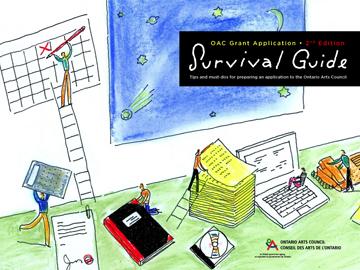So far we have succeeded in getting a grant from the Creative Industries Transition Fund to establish a sales Boutique area (gallery gift shop) at Affinity Gallery. Needless to say competition for grant money is brutal so what follows is useful stuff to help all of us write better grants in the future.
 |
| Ontario Arts Council Grant Application Survival Guide (available online) |
A short, catchy project name (not kitschy – catchy) provides quick identification and recall with the grant readers and decision makers. Beware of names that turn into four letter abbreviations or other unsavory words. Make sure the project name is on all your documents (and every page of multiple page documents).
Funders read hundreds of applications. “Storytelling“ will help your application stand out. Go beyond a dry recitation of facts and figures. Use compelling, emotional, gripping words, real life stories or examples, backed up with current statistics, data or research. Give your project a personality built on a solid base of facts with a heart touching voice.
Read the grant application carefully and thoroughly. If you have a question that is not covered in the application, call the funding source and ask for clarification. It is win-win; they help keep you on track and you provide them with a better application. Be mindful not to abuse the relationship by eating up their time with needless questions.
Assume the person reading the grant application knows nothing about you and/or your organization. You are explaining your project to a total stranger. Therefore you need to cover the basics: who, what, when, where, why, and how. The information should unfold logically, clearly and simply. In fact, have a trusted outsider read your grant application and give you feedback on their understanding of what you are proposing. They may discover glaring holes! Thank them profusely for their help, run back to your computer and edit.
Good typographic tips that will turn your sea of text into a easy to read and understand document (excerpt from Grant Writing for Dummies by Dr. Beverly A. Browning, MPA, DBA):
– Use lots of headings and subheadings to guide readers.
– Use numbered and billeted lists, and don’t be afraid to customize your bullets by using clip art or pictures in place of dots and squares.
– Keep paragraphs short, incorporating no more than 7 to 10 sentences in each paragraph.
– Unless otherwise specified, use a 12-point Times New Roman font
– Stick with one font to avoid a jumbled appearance.
– Use boldface or italics to emphasize key words and phrases when you want to speak directly to the reader (also the decision maker)
– Avoid using all capital letters or writing blocks of sentences in bold, italics or underlining.
